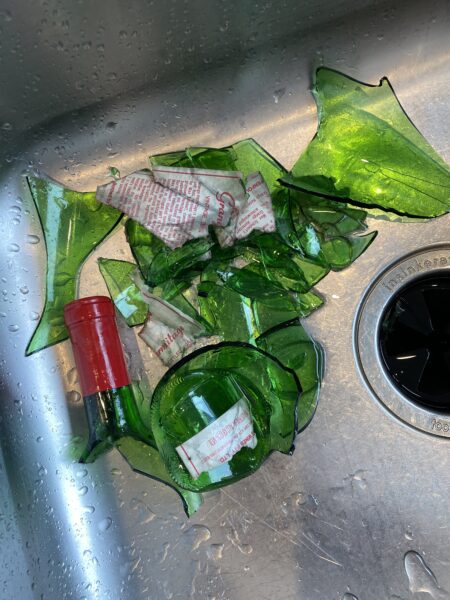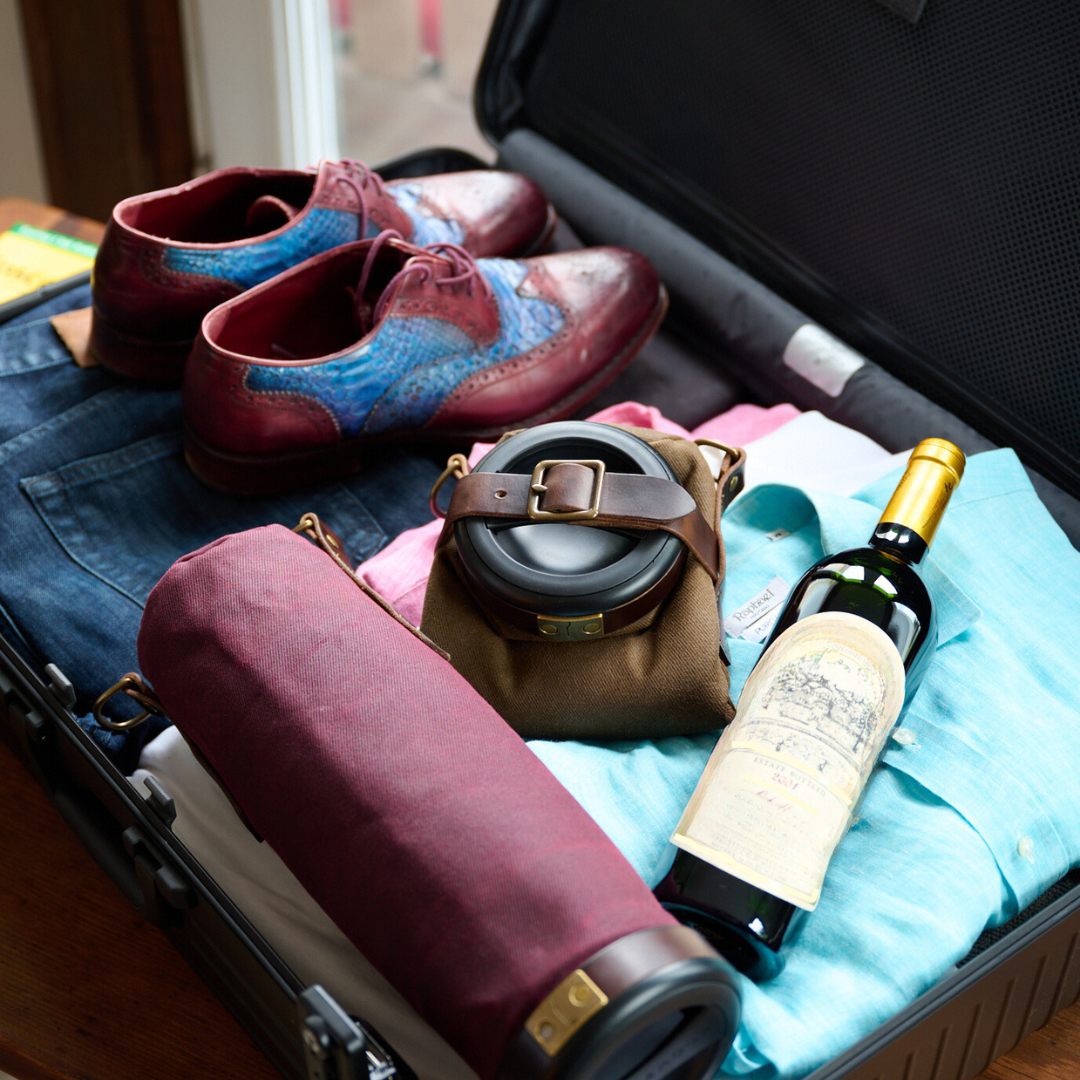
Coravin® Inventer/Founder Greg Lambrecht’s 1982 Penfold’s Grange
after a long flight to Boston’s Logan Airport
Whether you’re a wine enthusiast or simply looking to enjoy a special bottle on your vacation, traveling with wine can be nerve-wracking. The fear of arriving at your destination to find your cherished bottles shattered in your luggage is a genuine concern. In this blog piece, we going to get a little geeky explore ALL of the factors contributing to wine bottle breakage during flights and offer practical tips to minimize the risk.
Understanding the Air Travel Environment:
When wine travelers think about threats to their bottle the environment usually isn’t something that crosses their minds. Though this is a very small risk factor in bottle travel, for the sake of being thorough it needs to be pointed out. Airplane cargo holds are pressurized, creating significant pressure changes during take-off and landing. Although beefy champagne bottles are designed for future pressure changes, unfortunately most wine bottles aren’t always built to withstand these fluctuations. As the external pressure decreases during ascent, the air inside the bottle expands, potentially causing the cork or seal to pop. Conversely, during descent, the shrinking air inside the bottle can create stress upon the glass, predisposing it to breakage.
Temperature Fluctuations and Vibrations:
Another important factor is the varying temperature inside the cargo hold. As the plane cruises through different climate zones, the temperature can fluctuate, impacting the wine bottles’ structural integrity. Rapid temperature changes can weaken the glass, making it more susceptible to breakage. Additionally, the constant vibrations from the aircraft’s engines and movements can create micro-fractures in the glass, further increasing the risk of breakage.
Statistics on Wine Bottle Breakage:
While comprehensive statistics on wine bottle breakage during flights might be scarce, we do know that baggage damage in 2024 comprised over 49% of the complaints in a recent survey. There are numerous anecdotes and reports from travelers that indicate that bottle damage is not uncommon. The photograph above of the broken bottle in the sink was a bottle that was being flown from Australia to Boston, owned by the Inventor/Founder of the Coravin wine preservation system, Greg Lambrecht. He was gifted the bottle when visiting the Penfold’s winery, and it was special as it was a 1982 Grange Shiraz. Not only was that year given 97 points by Robert Parker and is considered in the top 10 of all of Penfold’s Grange vintages, it was also the birth year of his spouse, Jennifer. Greg painstakingly packed the bottle carefully by wrapping it like he had so many times before, in multiple layers of clothing. Ironically, he left his Vinarmour Wine Travel Carrier back in Boston, not anticipating he would bring any bottles back with him on this trip.
In theory (if you believe the airlines and airport public relations propaganda), none of us bottle travelers should have to take any major precautions when traveling with a bottle because their employees “care” about your baggage. We should be able to half-hazardly tuck it in our Samsonite or Rimoa with maybe a pair of blue jeans around it for good measure and be stacking it in our cellar later that eventing. We can thank Youtube for dispelling any of that suggested trust as it has provided us a number of hidden-camera exposés of what can really happen behind the scenes. Thanks to the sharing of YouTubers such as @viralhog , @Attitudeadjust3r , KTLA 5 , and TimesLIVE Video we now know what really can happen on the tarmac or in the conveyor-belt catacombs of an airport. And if you really want to go down the rabbit hole of the journey that your bag takes once it disappears from the ticketing agent’s hands down the conveyor belt, check out the video posted by Shake The Future. The fact is, traveling with anything fragile–bottled liquids or otherwise–is a gamble, and it is only a matter of time until the odds of the house prevail and you end up with a disappointing mess upon arrival at your destination.
The most popular–and inexpensive–method people use when flying with a bottle is to use a protective bottle sleeve. Basically industrial-graded bubble-wrap shaped like a wine bottle with either a velcro or ziplock-style closure. Common brands available on Amazon are JetBag, Wine Wings, and BottleShield, While this approach will certainly offer some protection to your bottle, it does have some serious drawbacks. Just ask Matthew Kaner, a Wine Enthusiast Magazine 2019 40 Under 40 recipient and FOOD&WINE’s 2013 Sommelier of the Year. While in Portugal seeking rare Madeira wines for his wine bar in L.A. he tried to bring a 160-year old bottle back to California in one such wine bag, only to arrive at LAX to find his luggage oozing a lovely-smelling brown liquid on the carousel. When conducting impact studies on these bags in 2019 I found that dropping a 3-lb lead weight on bottles from only about 22 inches resulted in not only the bottle breaking, but the shards of glass often puncturing the plastic allowing leakage of the contents.
Such tragic stories were the inspiration for the development of the Vinarmour Wine Carrier. Until we developed it, there had never been a patent on a puncture-proof bag of any sort. There was a reason for this–it was technically extremely difficult to do! But after nearly two years of research and development we patented the first and only bag to resist puncture. Using Dyneema (the world’s strongest fabric) two different types of Kevlar (used in the making of bulletproof vests) the Vinarmour Wine Carrier resists puncture from shards of broken glass, and along with a waterproof closure prevents any leakage onto luggage contents. However our tests actually show that this puncture protection is probably a little overkill. The special foam lining that we use absorbs over 90% of impact energy, meaning that it will take something like a catastrophic impact before your bottle will break. It really is the only wine travel bag that can give you peace-of-mind security when flying with a bottle.
Regulations and Guidelines:
Before traveling with wine bottles, familiarize yourself with airline policies and regulations concerning the transportation of alcohol. While most airlines allow passengers to carry wine as part of their checked or carry-on luggage, specific guidelines usually apply, especially internationally. Be aware of any restrictions on the number of bottles or the alcohol content allowed.
Final Tips for Packing Wine Bottles:
Packing wine bottles like a pro can significantly reduce the risk of breakage. Here are some expert tips:
1. Choose bottles with screw caps: Screw caps are less likely to fail under pressure changes compared to traditional corks.
2. Use the Vinarmour Wine Carrier. No other travel bag can protect agains impact, puncture, and leaks.
3. Separate bottles: Ensure the bottles and Carriers are placed individually, avoiding direct contact with each other.
4. Center placement: Position the wine bottles or Carrier in the center of your luggage to minimize exposure to external forces.
5. Label your luggage: Mark your luggage as “fragile” to alert baggage handlers to handle it with care.
6. Leave a hand-written note in your luggage to nicely ask any inspecting TSA agent to repack items EXACTLY as they found them to help protect the bottle.
Departing thoughts…
Traveling with wine bottles requires caution, common sense, and preparation given the unique environment of an aircraft’s cargo hold and the unpredictable daily disposition of baggage handlers. Understanding what happens behind the scenes at airports, as well as the impact of pressure changes, temperature fluctuations, and vibrations on wine bottles can help wine lovers take proactive measures to safeguard their precious cargo during flights. By investing in a superior carrier such as ours, and following expert tips, you can increase the chances of arriving at your destination with your favorite wine bottles intact and ready to be enjoyed..


